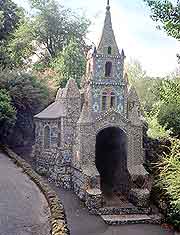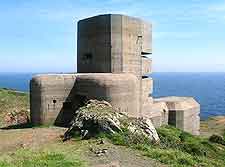Guernsey History Facts and Timeline
(Guernsey, Channel Islands, British Isles)

The island of Guernsey is steeped in history that dates back thousands of years. Recent archaeological discoveries point to human habitation here since 5,000 BC. Certainly, prehistoric remains abound on the island, including the Les Fouillages burial ground.
The Romans used Guernsey as a trading centre. It's thought that they arrived around 56 AD and stayed here for some 250 years. The discovery of a Roman ship 'The Asterisk' points to the importance of the island for those who chose to colonise it. The withdrawal of the Romans ushered in the Dark Ages and Guernsey's history at this time is rather uncertain. What is known, however, is that St. Sampson founded a church here and then, in the 7th century, a group of Bretons chose to settle on the island.
From the 12th to the 17th Centuries
During the 10th century, Guernsey was part of the dukedom of Normandy, under the leadership of William Longsword. Following the Norman invasion of 1066, the newly crowned King William I, who was also Duke of Normandy, took control of the island. When the Normandy territories were later ceded to King Philip II of
France, Guernsey decided to side with
England. It was a decision that was to change the course of the island's history for ever.
Guernsey was rewarded for its loyalty in 1215 when King John granted it certain rights and privileges, including an element of self-governance. Wary of French attacks at that time, building work was started to fortify the island, including the construction of Castle Cornet. Indeed, in the centuries that followed, the island was to fall victim to a number of French raids. Ownership also changed from English to French hands on several occasions. Finally, at the end of the 15th century, Pope Sixtus IV announced the neutrality of St. Peter's Port, which led to a period of peace.
Guernsey has always had close links with the sea, with many locals being involved in fishing and boat building. These links also include the dubious activity of privateering. The seizure of enemy ships was perfectly legal at that time, however, and from the 1600s onwards, the proceeds certainly helped to swell the island's coffers.

The Island in the 18th and 19th Centuries
During the early 1800s, Guernsey became a popular bolt hole for those fleeing the terrors of the French Revolution. They left their mark on the island in the form of some rather grand houses, many of which survive to this day. This was also a period of much change for the island. The Napoleonic Wars led to the building of no fewer than 16 forts and 58 coastal batteries on the island. The wars were to have a devastating effect on Guernsey, not least because trade with France and England dwindled considerably. Its economy was in a poor state, as were its sea walls, roads and many of its buildings.
From the mid-1900s on, Guernsey took upon itself major redevelopment works, including the extension of St. Peter Port's harbour and the building of a new harbour at St. Sampson. The French poet Victor Hugo lived on the island between 1856 and 1870. Many of his most famous works were written here.
Modern History and the War
During World War Two, Guernsey was occupied by German forces. Almost half of the island's people were evacuated to mainland England. Many defensive structures were also built. Between 1943 and 1945, a number of the island's inhabitants were deported to Germany. For those left on the island, life was harsh, with inadequate supplies becoming the norm. In May 1945, Guernsey was finally liberated.
After the war, the island transformed itself into a tourist destination, with the redevelopment of its old harbour into marinas. Tax rate reductions led to an influx of wealthy British people and Guernsey has today become an affluent offshore finance centre.
 The island of Guernsey is steeped in history that dates back thousands of years. Recent archaeological discoveries point to human habitation here since 5,000 BC. Certainly, prehistoric remains abound on the island, including the Les Fouillages burial ground.
The island of Guernsey is steeped in history that dates back thousands of years. Recent archaeological discoveries point to human habitation here since 5,000 BC. Certainly, prehistoric remains abound on the island, including the Les Fouillages burial ground.